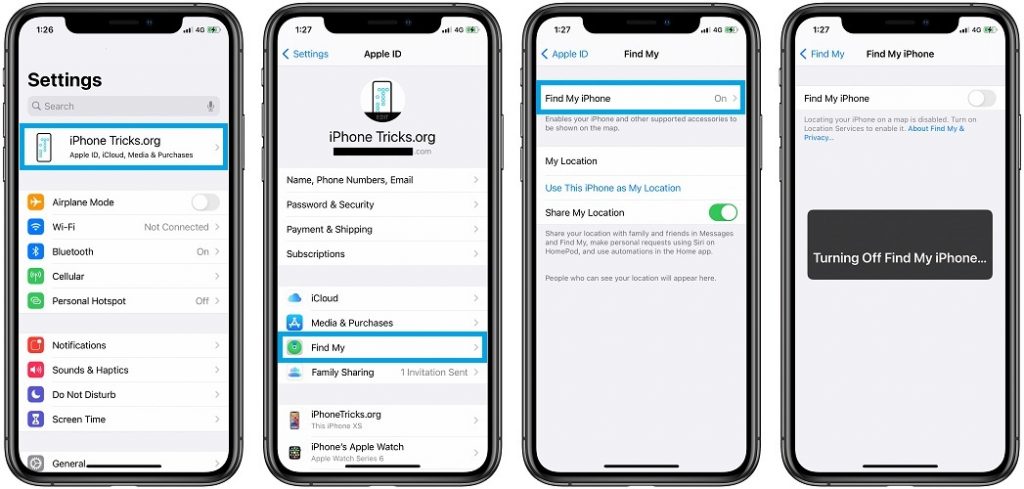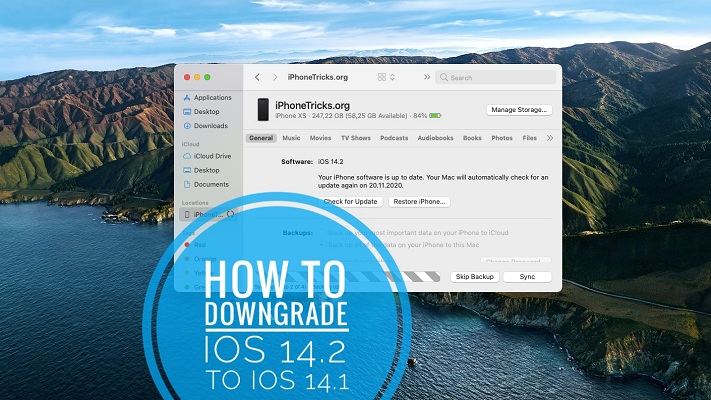How To Downgrade iPhone From iOS 14.2 To iOS 14.1 (Finder / iTunes)
Last updated on June 3rd, 2021 at 04:06 am
Posted in How To by Tyrone on November 19, 2020iOS 14.2 is the current software version for iPhone. It comes with a series of new features and bug fixes. However, on top of that it adds a serious bug that prevents some notifications in Messages from getting triggered. More, it also issues a read receipt to the sender. If you can’t live with this issue you can downgrade from iOS 14.2 to 14.1 and get your Messages notifications back.
The trade off, is that you will revert to another important bug that randomly mutes Ringer and Alerts on your device, an issue that flared up right after the public release of iOS 14.0. More, you will need a backup that you made in iOS 14.1 to restore from. If you haven’t backed up your device before updating to iOS 14.2, it’s too late to do it now, because backups made on higher iOS versions can’t be restored when downgrading.
Update: Apple has stopped signing iOS 14.1, making it impossible for users to downgrade from iOS 14.2!
7 Steps To Downgrade To iOS 14.1
If you’ve already been on iOS 14.1 you know what to expect. And if you find it better than the current iOS 14.2 here is what you can do to downgrade:
1. Download the iOS 14.1 ISPW File
You will need this file to install iOS 14.1 back on your device. You need a Mac or Windows computer to download this restore file. Pick the one that matches your iPhone model from the list available below:
- iPhone 12 Pro Max
- iPhone 12 Pro
- iPhone 12 mini
- iPhone 12
- iPhone SE (2nd Generation)
- iPhone 11 Pro Max
- iPhone 11 Pro
- iPhone 11
- iPhone XR
- iPhone XS Max
- iPhone XS
- iPhone X
- iPhone 8 Plus
- iPhone 8
- iPhone 7 Plus
- iPhone 7
- iPhone 6S Plus
- iPhone 6S
- iPhone SE
- iPod touch (7th generation)
2. Disable Find My iPhone

For the downgrade process to work you need to turn off Find My iPhone in the Settings app .
Tap on your Apple ID available at the top of the Settings home. Go for Find My and disable Find My iPhone.
3. Connect iPhone To Computer
Next up you need to connect your iPhone to the computer that you used for downloading the IPSW file. Use the Lightning to USB cable.
Tip: Unlock your iPhone to allow it to establish a working connecting with the macOS or Windows machine.
4. Open Finder (or iTunes)
If your Mac is on macOS 10.15 Catalina or later you have to open Finder, if your iPhone isn’t automatically detected. Click on your iPhone’s name, that should be available in the left sidebar under Locations.
Tip: If you’re running macOS 10.14 Mojave or earlier, or using a Windows PC you have to use iTunes! After opening iTunes click your iPhone’s icon available at the top of the window. You can also find your iPhone in the Devices section, available in the sidebar.
5. Trust Computer
If you’re connecting your iPhone to your computer for the first time, you have to trust the machine.
How To: In Finder, after you select your iPhone click on the Trust button. In iTune you have to click on Continue to achieve the same result.
6. Install iOS 14.1
Important: Before you start make sure that your MacBook or Windows laptop are plugged-in to prevent them from entering idle mode during the process. That’s if you’re using a notebook and not a desktop computer.

-
A. With Finder
- Make sure that you’re on the General tab.
- Press & hold the Option (alt) key and click on Restore iPhone.
- In the file browser pop-up, browse for the IPSW file that you downloaded at Step 1. Click it and select Open. A pop-up will appear, informing you that iOS 14.1 will be installed on your iPhone: “Your Mac will erase and restore your iPhone to iOS 14.1 and will verify the restore with Apple.”
Tip: This will overwrite iOS 14.2. Click Restore. Check your iPhone, you might be required to enter the Passcode. Keep your iPhone connected to your computer until it restarts and you get the iOS 14.1 welcome screen.
B. With iTunes
Make sure that you’re displaying the Summary view.
Press & hold Option (alt) key on Mac or Shift key on Windows and click Restore iPhone.
Follow the same steps mentioned at point A until iOS 14.1 is installed on your iPhone.
7. Restore iPhone From Backup
Downgrading iPhone from iOS 14.2 to 14.1 erases all data. If you have an iCloud, Finder or iTunes backup that you made in iOS 14.1 before you updated to iOS 14.2 you can restore it by either choosing:
– Restore from iCloud
– Restore from iTunes Backup
No matter what restore option you choose you need to keep your iPhone connected to the computer. Click the desired restoring option and choose the most recent backup. Click Restore.
Fact: If you encrypted your iOS 14.1 backup you need to enter the password to continue. Be patient until the restoring process finishes and unplug your device. That’s it!
Have you managed to downgrade your iPhone from iOS 14.2 to iOS 14.1? Use the comments section and share your feedback.
Related: The upcoming iOS 14.3 software version is currently beta tested. You can upgrade to the Public Beta by following the tips provided here.


When I follow Step 6B I get an error message saying “The iPhone “iPhone” could not be updated because the firmware file is not compatible. I’m on windows 7 and used the iPhone 8 ISPW File. Help!
Baz, thanks for commenting. Apple has stopped signing iOS 14.1, which makes it impossible to downgrade from iOS 14.2 to iOS 14.1 at this moment.